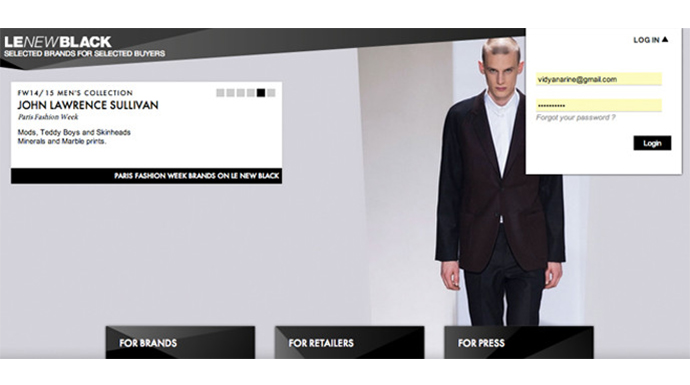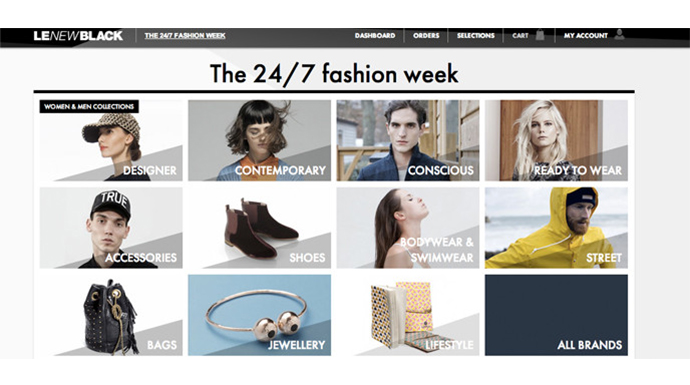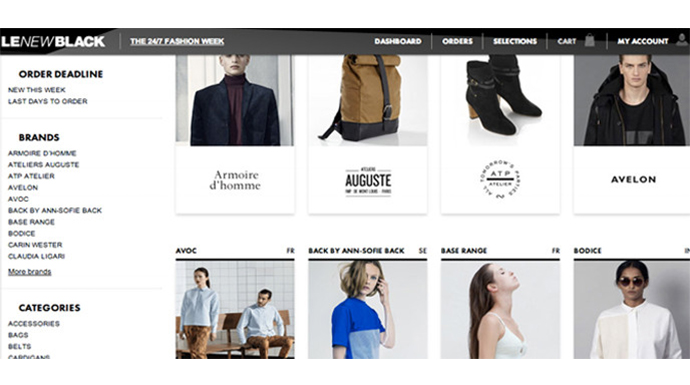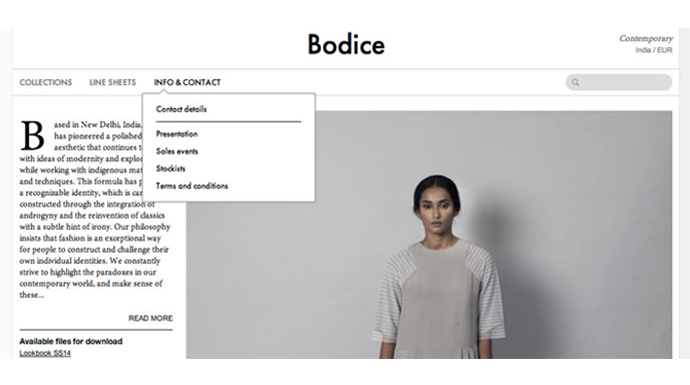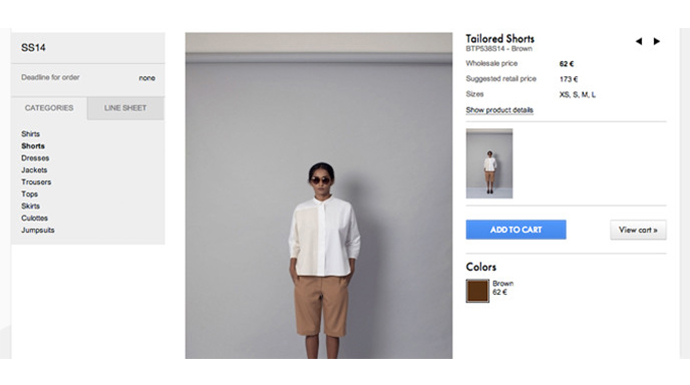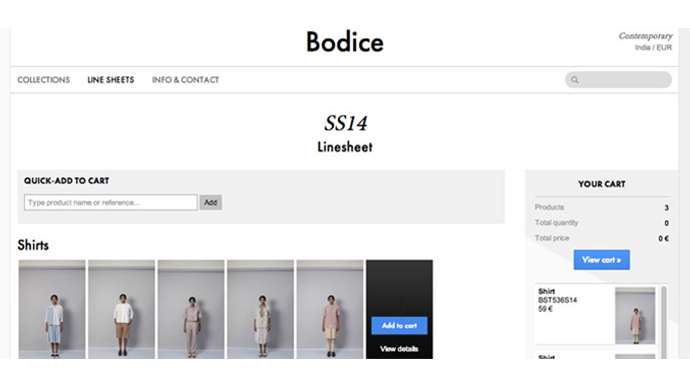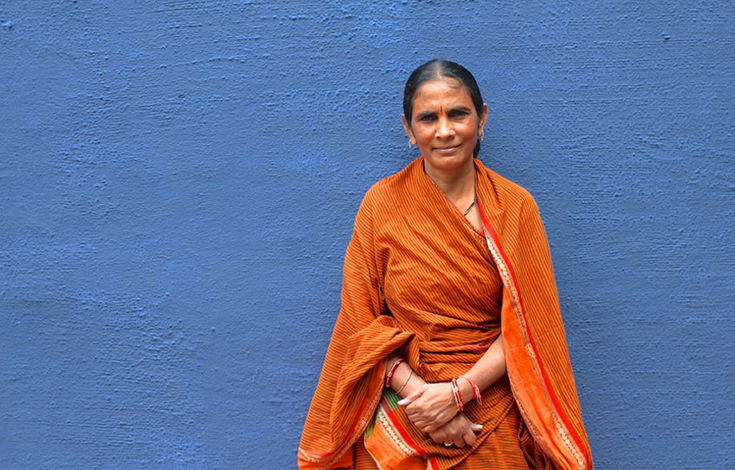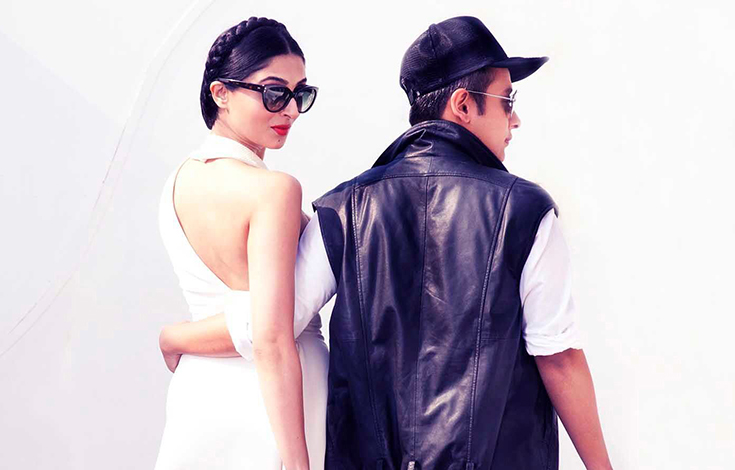What exactly is Le New Black?
The idea of Le New Black (LNB) was to bring together the most interesting brands that focused on quality of creation, production and distribution, and the most demanding retailers worldwide: concept-stores, department stores and buying offices. We mix emerging designers (Bodice, Rodebjer, Carin Wester, Etudes, Baserange etc) and more established ones (Henrik Vibskov, BACK by Ann-Sofie Back, Kenzo shoes, John Lawrence Sullivan, Sessùn, Baum und Pferdgarten etc). LNB allows brands to show and sell their collections throughout the duration of the whole season, and retailers to preview and discover collections, confirm quantities, and order online if they don’t travel. This mix makes retailers come to the platform and keeps them curious. Today we work with 180 brands and over 3000 retailers from 70 countries, such as Colette, Le Bon Marché, Harvey Nichols HK, Dover Street Market etc.
The business model is very simple – brands rent an online showroom space for a year. For example, if they were to go to a trade show they would rent a space for four days in one city. On LNB they rent a space for one year and it’s worldwide, permanent and instant. Pricing depends on the size of the brand – from very small brands at 2800 Euro to more established brands at 6000 Euro for a year. For example, more established brands work with agents all around the world so their agents have access to view orders and live statistics. Their buyers can see the collection in the price list matching with their territories.
We had to pivot after two years because we realized that some brands don’t want to be on the same platform as other brands. They need a more exclusive environment, like in real life.
For instance, Acne works out of their private showroom, they don’t go to trade shows anymore. So we had to create a system – we called it Le Privé – and we launched it and have been using it for one year now and they are very happy with it. We created it for Kris Van Assche and now brands like AMI Alexandre Mattiussi and Olympia Le Tan are working with it.
Initially we launched LNB as an online fashion trade show but we soon realized that it’s more of a tool. Just like if you go to a trade show and you don’t take appointments, nothing is going to happen. You will sit for four days and you will spend all your money doing nothing – and LNB is the same. It’s a tool that you have to work with to promote your collection to your prospects and retailers – you have to inform your buyers that you have an online showroom and they can see your collection online. You have to send a selection of products, purchase holders, private invitations through the site. We have developed all these tools for our brands so they can promote their collections. We have account managers here, their role is to accompany the brands from day one until the last day of registration to optimize sales tools, and to help them to integrate LNB in their sales strategy. LNB is a new tool in their workflow, and it takes time to absorb new habits. Our account managers are the necessary support and link for our brands.
Buyers usually like to see and touch products. How do you ‘replicate’ a typically physical and emotional experience online?
It was never our intention to replace the experience of a trade show. It’s important to meet people, to see collections and designers. We don’t replace the physical experience, we just complete it. Something that we say to prospective buyers all the time is that LNB was not meant to replace showrooms and trade shows – it is a way for buyers to prepare their buying sessions and for brands to prepare their sales campaign. What’s happening on LNB is that most of the time buyers discover brands online, then go to the shows or showrooms to meet the brands and view the collections. Then, they may order online.
It sometimes happens that they (buyers) order online and they’ve never met the brand, especially in the Middle East. Because most of the time, the Middle East doesn’t buy the same brands on a long term basis – they buy what they want and like now.
Before LNB, I wondered why there was no online solution for such a chic B2B industry. Also, fashion weeks worldwide represent an enormous expense of energy (planes, shipping collections, A/C, hotels etc). The idea behind LNB was also to propose a sustainable solution, with sustainable designs and a real economy of energy and money. Buyers and brands needed new tools to work together on the global market with trade shows and fashion weeks multiplying all over the world. We can’t be everywhere – we all love to travel in the fashion industry but it’s expensive and ultimately meeting people is finally not very qualitative. Buyers meet for 10 minutes and say they have to run to the Alexander Wang showroom and that they’ll ‘see you in Paris’ – and that’s it. Buyers and brands need time to work before, during and after the fashion weeks. If one day there is a buyer from somewhere in the world who goes to India to meet Ruchika because she saw Bodice on LNB and wants to learn more about her, about the way she works, about her inspirations – for me it would be a victory, a positive result for LNB. That’s what I hope we can create.
How did LNB’s partnership with the FDCI come about? What do you hope to achieve together?
When I came five years ago, it was because of Rendez-Vous, the trade show that I organised from 2005 to 2009. Even then I wanted to create a bridge between India and our market and I wanted to learn more about the designers there. We ended up bringing SavioJon for two trade shows – Rendez-Vous Paris and Rendez-Vous New York.
SavioJon is my favourite designer in India. Five years later in November 2013, I came back to see how the market had evolved and how we could work together to promote the scene. It’s funny because I met a lot of the same people from five years ago! Of course some designers are new and I don’t know everybody but overall, it felt familiar and that was nice.
It just happened because someone from FDCI knew LNB and they invited us and I talked to the organizer, Sunil Sethi. We came up with an award that we would give and we decided that we would bring a new designer on board every season and help the designer get used to the international market and vice versa. The aim of this collaboration is to give a chance to Indian designers who wish to learn more about the international market and to expand globally, and to allow our international network of 3000 buyers to discover and have a better understanding of the beautiful creative scene in India.
What are you looking for from Indian designers? What do you think will be well received by your network of buyers?
Like in any place I travel to, I am looking first of all for good design, coherent collections, a strong vision. We live in a global world and share common influences and dreams today. You can buy clothing in Thailand, wear it in in NYC and look really cool.
In India, beauty is everywhere in the colours, sensual femininity, various fabric qualities, the stories of designers who come from everywhere in this fantastic country, carrying their culture and specific backgrounds or craft technique, the comfortable yet sexy laid-back silhouettes …. I hope to transmit all that to our network of buyers through LNB.
Given that there are no showrooms in India, how do you foresee Indian brands joining a digital platform such as LNB?
We did meet a lot of designers during Fashion Week. We talked to Mrinalini, we didn’t have the time to meet Payal Pratap but I loved her collection – it was so beautiful – and also Gaurav Gupta of Akaaro. These are some of the designers that we liked the most. I hope that they will join us as soon as they are ready to use this new tool to expand globally. We talked to these and also to other designers who would need Le Privé for the Indian market, to help them manage this huge market in a more efficient way. They really liked the idea, and I feel like they need more time because it’s really new for them. So hopefully we will work soon with new Indian designers and provide them with our solutions!
What did you like most about Bodice’s aesthetic? What set it apart from others in the running?
What I felt about Bodice is that her designs want to talk to everyone in the world, not only to India. When we entered Fashion Week, Ruchika was the first person we saw and I told Emilio, my international business manager, to take a picture of her because she looked so good. A few days later we realized she was the designer behind Bodice. We had a crush on her, but then it was because her colour palette was so subtle, silhouettes so laid back yet elegant at the same time. Her Look Book was strong and coherent, and we also visited her store – it seemed like the beginning of something. It seems like she has a vision that goes beyond just a shirt, she can build a global brand. That’s not for all the Indian designers and maybe the domestic market is big enough.
The Indian territory is such a big business that maybe the international market is not interesting for everyone.
I think a lot of young people feel very close to Bodice’s vision. It’s a bit early to talk about the results of LNB for Bodice, because there’s a delay between our fashion weeks and yours, which are very late in the international calendar. Bodice had her S/S collection up beginning of November but buyers had bought their collections by mid-October. But she had visits from many great retailers – Assembly in New York and Hunting & Collecting in Belgium. I think both these stores are exactly the right scene for Bodice. It’s just that it will take some time for her to reach these places because they will need to meet and keep contact and she will need to adapt herself to the international calendar, and all this takes time. But for me it’s a very good first sign because it means we spotted a designer that fit our network of retailers and it was a good match. Hunting & Collecting or Assembly are exactly the kind of multi-label store we target.
What do you think about the retailers that only offer consignment to new upcoming brands? In India this is a common practice for almost all stores.
The whole face of the industry has totally changed in the last five years. Physical stores have increasingly become windows, where brands express themselves and customers try clothes, but then they buy online. Department stores have become rented spaces, like trade shows. With the rise of the internet, the job of the retailer has definitely changed, and it must be complicated for them to find the right balance again. Today big trade shows like Bread and Butter and Capsule open their doors to the end customer.
The brands that I know that are very strong in business have always refused consignment. Stores have to take responsibility towards designers and designers also have to learn to deliver on time and be reliable. It’s on both sides that this has to improve.
From what I’ve seen, all the strong businesses never did consignment because it’s not sustainable for designers and neither for the stores. It’s a real debate but if you want to create and build a strong local scene you have to support your own designers. They are very good at supporting their local designers in NYC for example, or London.
Do you have a personal connection to India?
My father was Indian but came from Trinidad and Tobago where all our family still lives. My father came to France when he was 20 years old and met my mother, who is Vietnamese. I think my roots are the reason why I go to India often and try to create a constructive and sustainable bridge.
Why is it important to you to bring Indian fashion to an international network?
I want people to learn through LNB that the Indian creative scene is great and professional.
There is a fear about Indian designers from the international point of view of the industry – because there’s a reputation that deliveries are not on time and messy. Also in the mind of the western market, India is a production market, rather than a creative market.
_________________
Vidya Narine is the Founder of Le New Black, a digital agency for established and emerging brands.

